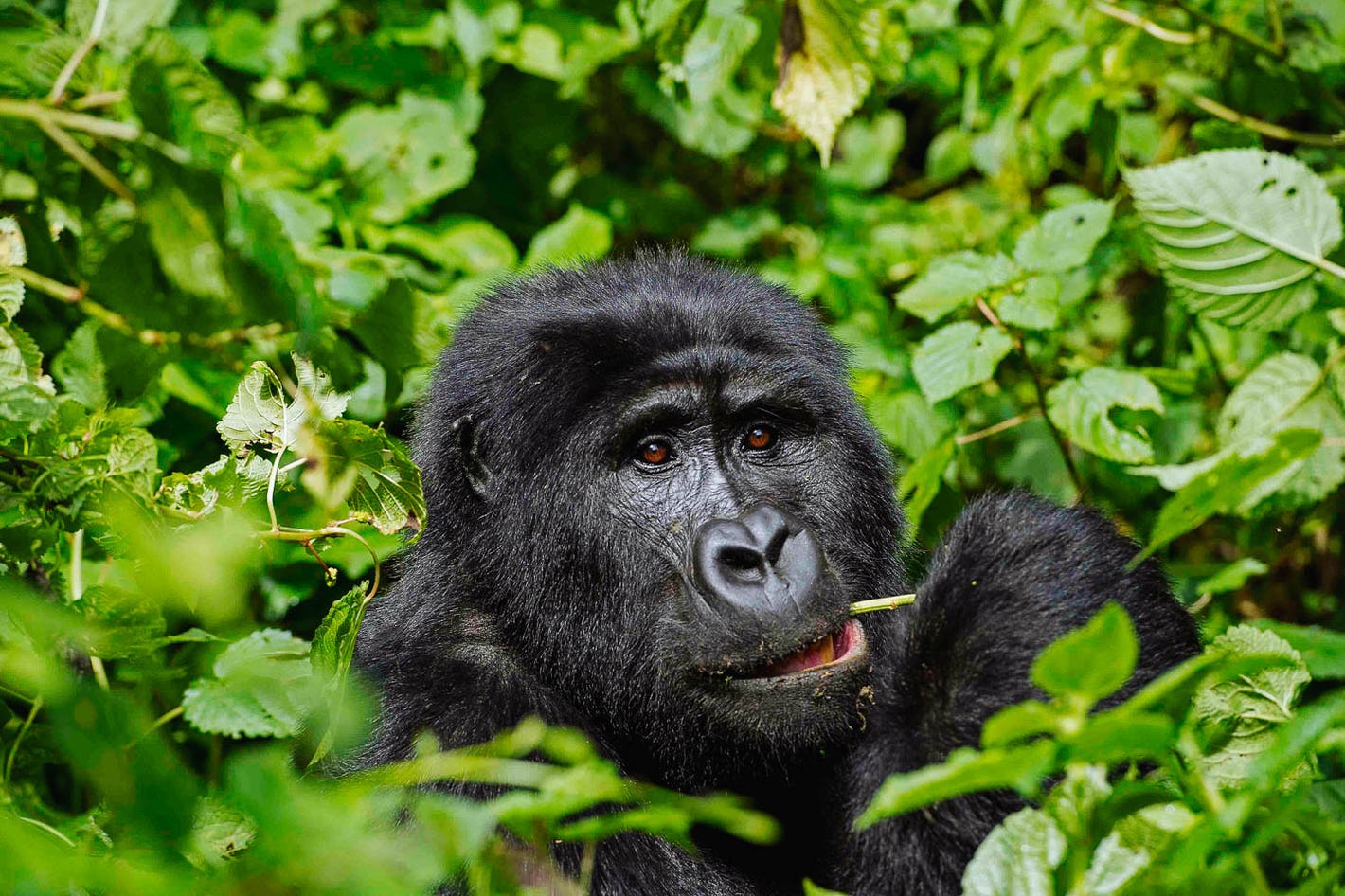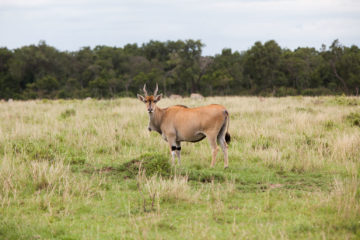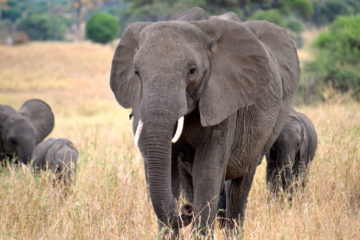Bwindi Impenetrable Forest National Park
The highlight of any Uganda safar trip is to track gorillas and the best place to visit for gorilla trekking, is Bwindi impenetrable forest is a UNESCO world heritage site and habitat for half of the world’s remaining mountain gorilla population. Gorilla tourism in Uganda started in Bwindi after successful habituation of 3 gorilla families at Buhoma in 1993. Fast forward today, there are 23 gorilla families habituated and guided gorilla treks allow visitors to see these endangered species in their natural habitat. The park is divided into four areas each with a number of habituated gorilla families as listed below;
- Buhoma
- Ruhija
- Rushaga
- Nkuringo
There are pros and cons to consider the best of Bwindi areas. Most important to note is to book a gorilla permitting advance 3-5 months for the area you think suits your interests. Interesting to know on the Bwindi areas is that the altitude and how easy or difficult it is to see gorillas, accommodation, accessibility depending on the itinerary and route. The rule of the thumb is that all sectors guarantee travelers to see gorillas any time of the year.

Wildlife In Bwindi Impenetrable Forest
Bwindi impenetrable forest national park covers about 331 sqkm, area of ancient evergreen tropical rainforest at the end of the Albertine rift valley in the southwest of Uganda. Altitude ranges from lowland forests in north around Buhoma at 1600 meters to afro-montane vegetation at 2,600 meters above sea level in the south Ruhija area. It’s considered one of the world’s most biologically diverse forest because it has stood the test of time having survived the last ice age 2,5000 years ago when earth’s rainforests shrunk and disappeared.
Nature walks give you the look and feel of the flora and fauna.
Wildlife found in Bwindi forest include 120 mammals, 10 primates including chimpanzees, over 364 birds including 26 species endemic to Albertine rift valley, 220 butterflies, 100 ferns, 163 species of trees, 27 species of frogs as well as 27 geckos and reptiles. The major attraction of the park is mountain gorillas making it the most famous park for travelers on a Uganda safari.
Bwindi’s Conservation history
Created as blocks of rain forests in 1932, Bwindi came to be designated as a national park in 1991 with the main objective of habituating gorillas to promote gorilla tourism. Bwindi is managed by Uganda wildlife Authority as Bwindi-Mgahinga Conservation Area. Habituation of gorillas started in 1993 and still continues to this very day. More families have been habituated to attract more travelers which also increases revenue from sell of gorilla permits. Money generated is put into local community support such as alternative ways of income generation to reduce dependence on forest.
Mountain gorillas are endangered, therefore strict eco-tourism limits human disturbance which can result from daily visits to gorillas. As a result, there’s a set of gorilla trekking rules and regulations which limit the number of gorilla trekkers to 8 people to visit one gorilla family per day.
Uganda Wildlife Authority offers a variety of volunteer opportunities for travelers as part of the various activities available in the departments such as research, tourism and community. there are support organizations that work with Bwindi such as conservation through public health (CTPH), gorilla doctors, international gorilla conservation program. These also work across the gorilla range states including Rwanda and DR Congo.
Some volunteering areas like research require skills and knowledge while others just need you to have the desire and enthusiasm such as community education and conservation.
Gorilla trekking In Bwindi Forest
The visit to see gorillas is the main highlight for Uganda safaris and the number one reason to travel to Bwindi. There are 23 gorilla families that have been habituated, so guided gorilla treks allows travelers to take pictures and see mothers grooming their young ones as silverbacks guard their families jealously. Gorilla Tracking takes place at 4 gorilla centers which are Buhoma, Ruhija, Rushaga and Nkuringo and can do any time of the year but best done in the dry season during the month of December to February and June to September. Rainy season is also a great choice because the gorilla tracking experience remains the same. You should book a gorilla permit through a trusted tour operator in advance because the fact that gorilla trekkers are limited to 8 people per day so as are the permits.
The gorilla trekking permit goes for US$700 for foreign non residents and US$600 for foreign residents.
Gorilla habituation Experience
Gorilla habituation is an extraordinary experience giving tourists 4 hours encounter with semi-habituated gorillas. Visitors can learn what it takes to habituate gorillas for tourism. Habituation is a research process that can take 2-3 years where trackers, researchers train gorillas to get used to human presence without changing their natural behavior. With gorilla habituation, visitors are allowed to take part in habituating gorillas through research based activities such as chewing on vegetation, walking on knuckles, imitating gorilla vocals among others. Comparable to tracking, habituation is restricted to 4 visitors per day and can be done only in Rushaga sector of Bwindi.
Hikes and nature walks
The mountainous terrains of Bwindi creates some pretty amazing hiking and nature walking opportunities throughout all the gorilla centers as well as in the local communities. Buhoma is a favorite place for nature walks as it has amazing waterfall trails. Visit Ruhija sector to hike to the largest swamp Mubwindi in the middle of the rainforest. There are nearly hiking and nature walks in every sector of Bwindi including Nkuringo and Rushaga. Guided walks begin in the morning at 09 am or afternoon at 2 pm. You will see nature’s most beautiful flowers like orchids, largest and native trees like brown mahogany as well as enjoy butterflies sights and sounds of nature.
Bird watching in Bwindi Forest
Listed by the African Birding Club 2013 as Africa’s number one bird watching destination, Bwindi is home to more than 345 species including 90 % of the bird species endemic to the region. Rare species like short tailed warbler can be searched for in Buhoma and then the highlighted species like African green broadbill, stripe breasted tit can be observed in Ruhija sector. Better birding trails include River Ivitrail in Buhoma, bamboo trail in Ruhija, waterfall trail in Buhoma.
Community walks
You will get to meet and socialize with people living around Bwindi forest some of which have set up their own cultural tours, tourism businesses as well as conservation projects. Walks are led by local guides introducing you to southwestern Uganda’s cultures like the BaTwa pygmies, Bakiga and Bafumbira. While visiting the local villages around Bwindi, you will learn how many experiences like weaving, tasting banana beer, fire making without match sticks, hunting, bow and arrow shooting with BaTwa and be taken into another world by their energetic traditional dance performances and drumming. There are also health and education projects where funds from gorilla tourism provide local communities around Bwindi with access to clean water, building schools and many more that empower the people to improve their wellbeing as well as support conservation.
Bwindi is located in southwestern Uganda 512 km about 9-10 hour drive from the capital city Kampala/ Entebbe airport, 3-hour drive from Queen Elizabeth national park. Visitors can fly by charter aircraft into Kisoro airstrip or Kihihi airstrip and get to the park by 1 hour drive or less. Visitors landing at Kigali can easily access the park’s southern sectors of Ruhija, Rushaga and Nkuringo. It is 3-hour drive from Kigali which allows for short 1-day gorilla safari.






Tour Reviews
There are no reviews yet.
Leave a Review